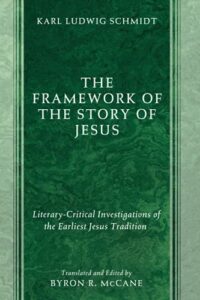 I bear glad tidings of good news. Karl Ludwig Schmidt’s magnum opus has finally been translated into English. The publication date is 2021, but I became aware of it earlier this month. The translator, Byron R. McCane was also responsible for the highly readable The Place of the Gospels in the General History of Literature, which is a good sign.
I bear glad tidings of good news. Karl Ludwig Schmidt’s magnum opus has finally been translated into English. The publication date is 2021, but I became aware of it earlier this month. The translator, Byron R. McCane was also responsible for the highly readable The Place of the Gospels in the General History of Literature, which is a good sign.
Schmidt became somewhat of a star in the world of biblical scholarship after the publication of Der Rahmen der Geschichte Jesu. In it, he laid out the evidence for the nature of the framework in Mark’s gospel — namely that it was based on separate pieces of oral tradition, hung upon a mostly secondary structure. In previous decades, the theory of Markan priority among the synoptics had gained many adherents and eventually became the overwhelming consensus position.
Emboldened by that consensus, many scholars (mostly Protestant) attempted to write modern biographies of Jesus using the synoptics as their source material and leaning heavily on the second gospel for details concerning their chronology and topological itinerary. (This is what Schweitzer called Leben Jesu Forschung or “life of Jesus research.”) William Wrede and, to some extent, Albert Schweitzer demolished the idea that this was even possible. In The Messianic Secret (1901), Wrede sought to demonstrate that Mark’s overall narrative does not have a coherent narrative structure, but is instead arranged thematically and theologically. Julius Wellhausen in his analyses of the gospels came to the same conclusion, making the case emphatically in Einleitung in die drei ersten Evangelien (1905).
The foundations of form criticism
These predecessors laid the groundwork for Schmidt, who in Framework painstakingly analyzed the perocopae of Mark’s gospel and their related sections in Matthew and Luke. Rudolf Bultmann hailed the work as an impressive and important achievement which would provide the foundation for form criticism. On the other hand, conservative scholars, especially apologists in the English-speaking world, attacked it on various fronts. Probably the most well-known sustained attack came from Methodist minister David R. Hall. He criticized Schmidt’s assumptions and arguments in The Gospel Framework: Fiction or Fact?, a book you can read for free on archive.org.
For those readers not fluent in German, Hall’s book may have been a bit frustrating. Similar to the experience of reading Origen’s Contra Celsum, wishing than an extant copy of The True Word had survived for comparison, we wonder whether Hall has given Schmidt a fair shake. But now, after more than a century, we have an English translation.
I hope to post more on Rahmen in the coming weeks, as time permits, but for now I would like to offer a few words about translating German into English. In previous posts, I have sometimes translated Der Rahmen der Geschichte Jesu as The Framework of the History of Jesus. As you probably know, the word Geschichte means both story and history. However, I think our translator got it right with The Framework of the Story of Jesus, and the proof is in the subtitle: Literary-Critical Investigations of the Earliest Jesus Tradition. Schmidt is not offering up a strictly historical-critical work here. He’s staying, for the most part, on the layer of the text itself (in its disconnected pericope form), examining the textual clues related to the formation of the gospels from the received tradition. Continue reading “K. L. Schmidt’s The Framework of the Story of Jesus: Now in English!”
